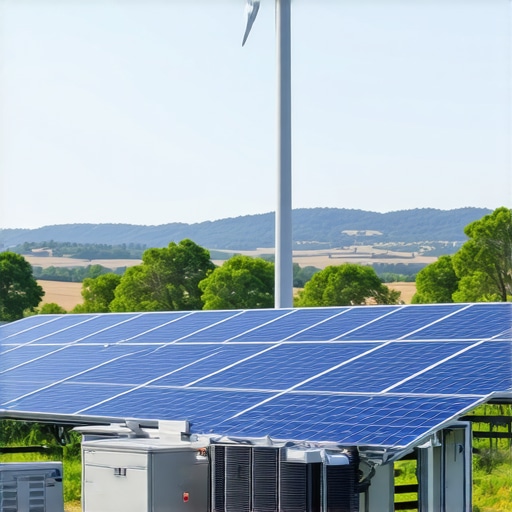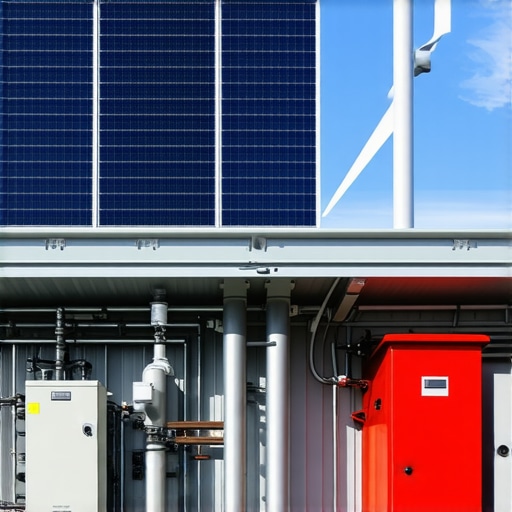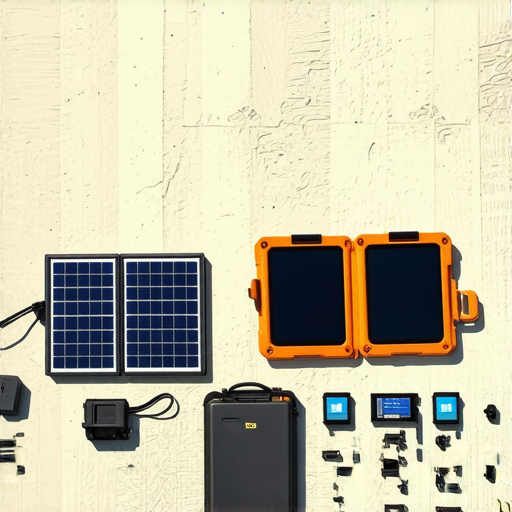My First Encounter with Off-Grid Power Solutions
Last year, I decided to embrace a more sustainable lifestyle by exploring off-grid living. I vividly remember my first day researching solar generators, overwhelmed by options but eager to find reliable power solutions that could keep my small cabin running without grid access. That initial curiosity led me down a fascinating path of discovering the best solar generators and power kits for 2025, which I now consider essential for anyone serious about off-grid independence.
What Makes a Solar Generator Stand Out?
In my quest, I learned that not all solar generators are created equal. Some boast higher wattage capacities, while others shine in portability and ease of use. After testing several models, I found that the key factors were battery capacity, inverter quality, and the number of AC/DC outlets. For instance, the Portability and durability of a solar generator can be real game-changers when you’re off the grid and need dependable power on demand. I personally prefer units with smart battery management systems, which extend the lifespan and efficiency of the device.
How Do Power Kits Enhance Off-Grid Living?
Power kits, combining solar panels with generators and batteries, are like my personal energy ecosystem. I found that investing in a complete solar power kit, like the ones described in my favorite solar industry reports, offers the flexibility to expand and adapt to my evolving energy needs. These kits often include portable solar panels, which are perfect for quick setup and charging, especially when I’m camping or spending extended time outdoors. The synergy between panels and batteries ensures I have power even during cloudy days or at night, which is crucial for off-grid sustainability.
What Should I Consider When Choosing the Best Solar Power Kit?
Choosing the right kit requires balancing power output, portability, and budget. I recommend assessing your energy consumption first—what appliances you need to run and for how long. Then, match that with a solar generator and panel system that can comfortably meet those demands. Personally, I lean towards brands with good customer reviews and proven durability, like those reviewed on Consumer Reports. It’s also wise to consider future expansion options, so your off-grid setup can grow with your needs.
Why Is Reliable Off-Grid Power Critical for Sustainable Living?
Having a reliable power source means I can focus on my sustainable lifestyle without constant worry about power outages or running out of juice. Properly selected solar generators and power kits provide peace of mind, making off-grid living not just feasible but enjoyable. For example, being able to keep my phone charged for emergencies or powering a small refrigerator keeps my daily life comfortable and secure. According to the National Renewable Energy Laboratory, advances in solar technology are making off-grid energy more efficient and accessible than ever before.
If you’re considering a move to off-grid living or just want backup power for emergencies, I encourage you to share your experiences or ask questions in the comments. Exploring the best solar generators and power kits is a personal journey, but it’s one that can truly transform your sustainability efforts.
Innovating Off-Grid Power Storage: Beyond Basic Batteries
As I delved deeper into off-grid energy solutions, I discovered that battery technology is evolving rapidly, with lithium iron phosphate (LiFePO4) batteries gaining popularity for their safety, longevity, and thermal stability. These batteries outperform traditional lead-acid models, offering higher cycle life and faster charging times, which are crucial when managing irregular sunlight or wind conditions. Integrating such advanced batteries into your power system not only enhances reliability but also simplifies maintenance, a critical factor for long-term off-grid residence.
How Can Smart Energy Management Optimize Off-Grid Systems?
Implementing smart energy management systems (EMS) is a game-changer for maximizing efficiency. These systems intelligently monitor energy production, storage, and consumption, allowing real-time adjustments that prevent overloads or unnecessary power drain. For example, with EMS, you can set priority levels for essential appliances, ensuring critical devices like medical equipment or communication tools always stay powered. Moreover, some EMS integrate AI algorithms that predict energy needs based on historical usage patterns, further refining system performance and lifespan.
Is Microgrid Technology the Future of Off-Grid Living?
Microgrids, localized energy networks that can operate independently or in conjunction with the main grid, are gaining traction among off-grid enthusiasts and communities. They offer modularity, resilience, and scalability—key advantages in remote locations prone to power disruptions. By combining multiple renewable sources, such as solar, wind, and even small hydro, microgrids can provide a steady and reliable power supply. According to a U.S. Department of Energy, microgrid deployment enhances energy security and supports sustainable development, making it a compelling choice for future off-grid projects.

What Practical Challenges Should Off-Grid Innovators Anticipate?
While technological advancements make off-grid living more feasible, practical hurdles remain. Weather variability, system scalability, and initial costs are significant considerations. For instance, unpredictable weather can reduce renewable energy output, necessitating backup solutions like diesel generators or grid interconnection options for emergencies. Additionally, investing in scalable systems from the outset ensures that your energy setup can grow with your needs, avoiding costly overhauls. Educating oneself on local environmental factors and choosing reputable, durable equipment can mitigate many of these challenges, ensuring a resilient and sustainable off-grid lifestyle.
If you’re exploring off-grid power solutions or refining your existing setup, I’d love to hear about your experiences. Share your insights or ask questions in the comments, and let’s build a community focused on sustainable independence.
Embracing the Complexity of Off-Grid Power Management
As I delved deeper into off-grid living, I realized that managing energy isn’t just about installing a solar generator and hoping for the best. It involves a nuanced understanding of how different components interact under varying environmental conditions. For example, I’ve learned that integrating multiple renewable sources like wind turbines alongside solar panels can significantly enhance system resilience, especially during long, cloudy winters or stormy seasons. This layered approach requires careful planning and sophisticated energy management systems, which can monitor, predict, and adapt to fluctuating inputs, ensuring a steady power supply even in adverse weather.
What Are the Hidden Challenges of Scaling Off-Grid Systems?
Scaling an off-grid system from a small cabin to a more substantial property presents numerous challenges. Initially, I underestimated the importance of future-proofing my setup. Adding capacity later often involves costly upgrades or complete overhauls. Advanced battery technologies like lithium iron phosphate (LiFePO4) have been game-changers, offering higher energy density and longer cycle life—crucial for scalable systems. According to U.S. Department of Energy, these batteries are pivotal in creating sustainable, expandable off-grid solutions. Planning for scalability from the outset, with modular components and smart energy management, has saved me time and money while providing peace of mind.
How Do Smart Energy Management Systems Elevate Off-Grid Living?
Implementing smart EMS has transformed my off-grid experience. These systems provide real-time insights into energy production, storage, and consumption, enabling me to make informed decisions. For instance, during peak sunlight hours, I can prioritize charging devices or running appliances, while conserving power during cloudy days. Some systems even incorporate AI algorithms that analyze usage patterns, predict future needs, and optimize energy flow accordingly. This level of control not only maximizes efficiency but also extends battery life and reduces maintenance—crucial factors for long-term off-grid sustainability.
Can Microgrid Technology Revolutionize Remote Communities?
Microgrids are increasingly becoming a viable solution for remote or underserved communities. They provide a decentralized, resilient network that can operate independently, integrating diverse renewable sources like solar, wind, and small hydro. My experience with microgrid principles has shown that their modular nature allows for incremental expansion, making them adaptable to changing energy demands. According to U.S. Department of Energy, microgrids significantly enhance energy security and sustainability, especially in areas prone to natural disasters or grid failures. For individual off-grid enthusiasts, adopting microgrid concepts can mean the difference between intermittent power and reliable independence.

What Are the Practical Considerations for Long-Term Off-Grid Living?
Beyond technical innovations, practical considerations like weather unpredictability, maintenance, and initial investments remain critical. I’ve learned that choosing durable, weather-resistant equipment and preparing for seasonal variations is essential. For example, in winter, snow accumulation can impact solar panel efficiency, so regular maintenance and strategic placement are vital. Additionally, educating oneself about local environmental conditions and investing in high-quality, scalable systems can mitigate many unforeseen issues. These steps help create a resilient off-grid setup capable of supporting a sustainable lifestyle over decades.
How Can I Share My Off-Grid Journey and Learn From Others?
Sharing experiences and exchanging knowledge has been invaluable on my off-grid journey. Whether through online forums, community groups, or local workshops, learning from others’ successes and challenges accelerates personal growth and system optimization. I invite readers to comment below with their own stories or questions—your insights can inspire and inform fellow enthusiasts. Together, we can build a supportive community dedicated to sustainable independence and continuous innovation in off-grid power solutions.
Harnessing Hybrid Renewable Systems for Maximal Resilience
Expanding beyond solo solar setups, I have increasingly integrated hybrid renewable systems—combining solar, wind, and micro-hydro sources—to create a more resilient off-grid energy ecosystem. This layered approach ensures continuous power supply during adverse weather or seasonal variations, especially in remote locations where grid connection is unfeasible. For example, a small wind turbine, strategically placed on a wind-swept ridge, can provide supplementary energy during overcast days, complementing solar panels that excel in sunnier periods. This synergy not only stabilizes energy output but also optimizes resource utilization, reducing dependence on backup generators and fossil fuels.
Implementing Advanced Energy Storage: Beyond Lithium Iron Phosphate
While LiFePO4 batteries have revolutionized off-grid storage, emerging technologies like solid-state batteries and flow batteries are poised to further elevate system reliability. Solid-state batteries, with their higher energy densities and enhanced safety profiles, could dramatically extend off-grid autonomy. Meanwhile, flow batteries, capable of scalable storage capacities, are particularly suited for larger setups requiring prolonged energy reserves. Incorporating these cutting-edge storage solutions demands meticulous planning but offers substantial long-term benefits, including reduced maintenance and increased lifespan. According to U.S. Department of Energy, these innovations are on the cusp of transforming renewable energy storage, promising more sustainable and resilient off-grid communities.
Optimizing Energy Management with AI and IoT Integration
Advanced energy management now leverages artificial intelligence (AI) and Internet of Things (IoT) technologies to fine-tune off-grid systems. I have experimented with systems that analyze real-time data on weather patterns, energy consumption, and system health, enabling predictive adjustments for optimal performance. For instance, AI algorithms can forecast sunlight availability and preemptively adjust battery charging schedules, maximizing efficiency. IoT sensors monitor each component, alerting me to potential issues before failure occurs, ensuring continuous operation and reducing downtime. This intelligent approach not only enhances system longevity but also simplifies maintenance, making off-grid living more practical and less labor-intensive.
Can Microgrid Technology Facilitate Community-Scale Sustainability?
Microgrids, as modular and scalable energy networks, hold immense promise for remote communities and eco-villages. My experience with microgrid principles has shown that integrating diverse renewable sources within a single network can significantly boost reliability and resilience. For example, a community microgrid combining solar, wind, and small hydro can operate independently, providing power during grid outages or natural disasters. The ability to expand incrementally aligns with evolving community needs and technological advancements. According to U.S. Department of Energy, deploying microgrids enhances local energy independence, reduces transmission losses, and fosters sustainable development—an ideal blueprint for future off-grid innovations.

Addressing Practical Challenges in Scaling Up Off-Grid Systems
Scaling an off-grid setup from a single cabin to a larger property introduces complexities that demand strategic foresight. I have learned that initial investments should prioritize modular, expandable components—such as scalable batteries and versatile inverters—to accommodate future growth without costly replacements. Weather unpredictability, especially during winter months, necessitates protective measures like panel tilting and snow clearing to maintain efficiency. Additionally, integrating remote monitoring and control systems can preemptively identify issues, reducing downtime and maintenance costs. Planning with these considerations in mind ensures a resilient and adaptable energy infrastructure capable of supporting an expanding off-grid lifestyle over decades.
Engaging with the Off-Grid Community for Continuous Innovation
Active participation in online forums, local workshops, and knowledge-sharing networks has been invaluable for my journey. Engaging with pioneers and experts allows for exchange of advanced techniques, troubleshooting tips, and emerging technologies. I encourage fellow enthusiasts to share their experiences, especially regarding innovative storage solutions or hybrid system designs. This collaborative approach accelerates learning, fosters innovation, and helps us collectively overcome challenges inherent in off-grid living. If you’re passionate about sustainable independence, I invite you to connect, ask questions, and contribute your insights—together, we can push the boundaries of what off-grid energy solutions can achieve.
Things I Wish I Knew Earlier (or You Might Find Surprising)
Mastering Scalability
When I first started my off-grid journey, I underestimated how challenging it could be to scale my system later on. Investing in modular, expandable components from the start saved me a lot of headaches and money down the line. It’s like planting a seed that grows with you, ensuring your energy needs are met as your lifestyle evolves.
The Weather’s Hidden Impact
I learned the hard way that weather unpredictability, especially during winter, can significantly reduce solar efficiency. Regular maintenance, like clearing snow and adjusting panel angles, became part of my routine. Being prepared for seasonal changes is crucial for maintaining a reliable power supply.
Beyond Batteries: Cutting-Edge Storage Tech
While lithium iron phosphate batteries are fantastic, newer storage technologies like solid-state and flow batteries are on the horizon. They promise higher capacity and longer lifespan, which could revolutionize off-grid living. Staying informed about these innovations helps me plan for future upgrades.
The Power of Smart Management
Implementing AI and IoT in my energy system has been a game-changer. Real-time monitoring and predictive adjustments ensure optimal performance and extend battery life. It’s like having a personal energy coach guiding my system 24/7.
The Role of Microgrids in Community Sustainability
Microgrids, combining various renewable sources, offer resilience and scalability. I see them as the future for remote communities and eco-villages, providing reliable power even during disasters. The ability to expand gradually makes them an attractive solution for ambitious off-grid projects.
Resources I’ve Come to Trust Over Time
- National Renewable Energy Laboratory (NREL): Their research and reports have deepened my understanding of renewable tech and system design. Highly recommended for anyone serious about off-grid energy.
- Consumer Reports: Their reviews on solar generators and batteries help me choose durable, reliable equipment without guesswork.
- Energy.gov: Official government insights into microgrid and storage innovations keep me updated on cutting-edge developments.
Parting Thoughts from My Perspective
Embracing off-grid solar power has been one of the most rewarding challenges of my sustainable lifestyle. The key takeaway is that preparation, continuous learning, and staying adaptable are vital. Whether it’s scaling your system, integrating new storage tech, or managing seasonal variations, each step brings you closer to true energy independence. If this resonates with you, I’d love to hear your thoughts—share your experiences or questions in the comments. Together, we can push the boundaries of off-grid living and create resilient, sustainable communities.

